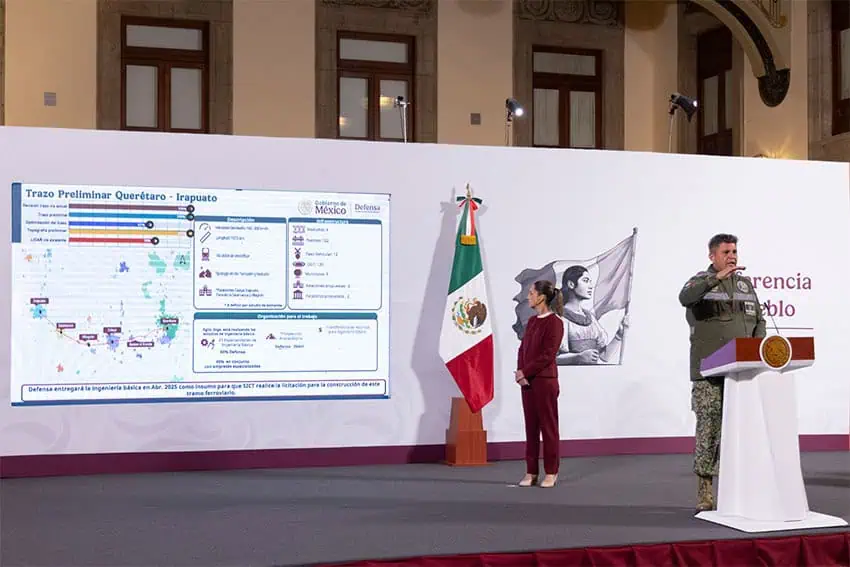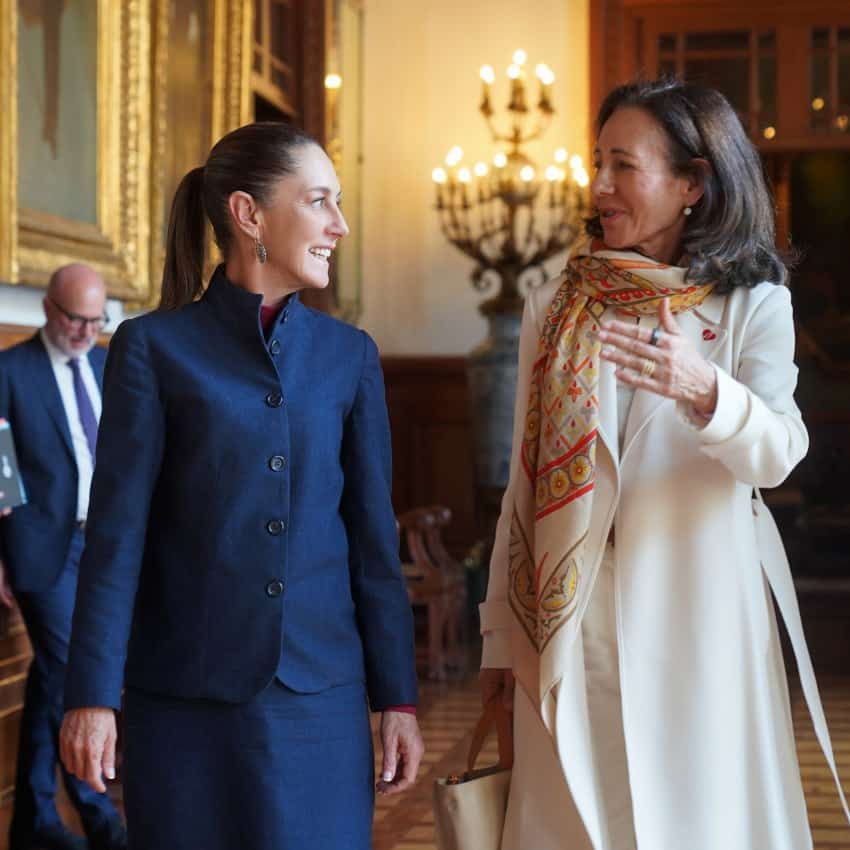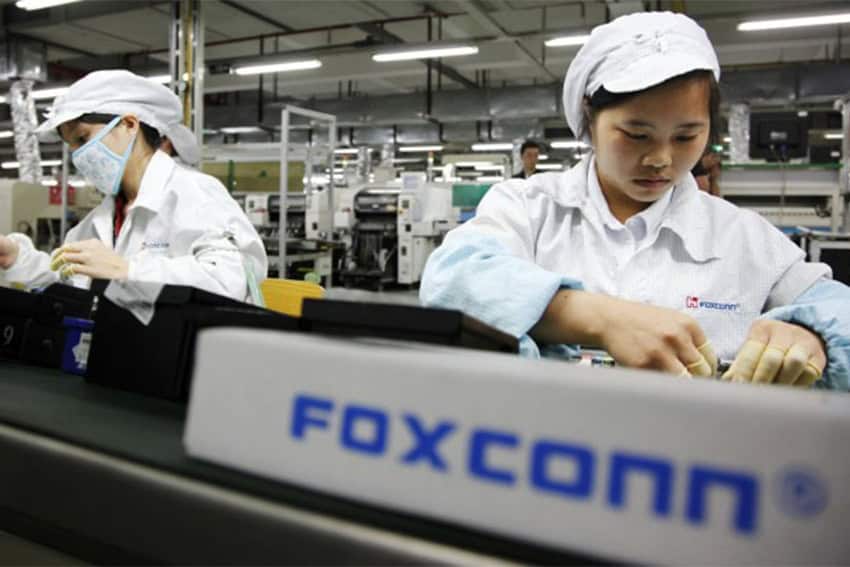On Feb. 6-7, Mexico News Daily and Querencia hosted the “Future of Mexico Forum” at the Querencia Private Golf & Beach Club in Los Cabos, Baja California Sur. The forum brought together leaders from Mexico and the United States to discuss the future of Mexico across a diverse range of topics. As part of this Forum, the MND team conducted a series of exclusive interviews with each of the speakers and will be sharing the highlights with you in this series.
On the second day of the event, Mexico News Daily CEO Travis Bembenek moderated a session on “Nearshoring and Mexico’s Business Landscape” with Pedro Casas Alatriste, executive vice president and CEO of the American Chamber of Commerce of Mexico (AmCham).
During the session, Casas said he sees a “very bright future for Mexico” in an economic sense, in part because he believes that Mexico will avoid the tariffs United States President Donald Trump has proposed placing on its exports. He also believes Mexico could benefit from increased U.S. trade protectionism against China.
However, Casas acknowledged that Mexico needs to overcome a range of challenges — including ones related to energy, water, security, infrastructure and human capital — to capitalize on its economic opportunity in the years ahead.
This article draws on his comments in his forum session, and his remarks during a subsequent interview with Mexico News Daily.
US tariffs on Mexican exports ‘no longer an option’
Casas highlighted the high level of economic integration between Mexico and the United States as a result of developments since the entry into force in 1994 of the North America Free Trade Agreement, or NAFTA, which was superseded by the USMCA in 2020.
“The economic relation between the U.S. and Mexico has evolved in the past three decades from being trading partners to being part of a co-production system,” he told MND.
Although Trump may disagree, Casas asserted that the imposition of U.S. tariffs on Mexican exports would therefore be self-defeating — “a shot in the foot” as Economy Minister Marcelo Ebrard put it.
The United States’ trade deficits with other trade partners, such as China and Vietnam, “could be solved through tariffs, but the relationship with Mexico is now one that is so integrated that tariffs are no longer an option,” the AmCham CEO said.
“If you put tariffs on Mexican exports, you are — statistically speaking and literally speaking — also imposing tariffs on yourself, yourself being the United States, because the value add of U.S. in Mexican exports is quite high,” Casas said, emphasizing Mexico’s dependence on manufacturing sector inputs that are made in the U.S.
He also highlighted that U.S. companies are significant exporters of manufactured goods from Mexico to the United States. The annual value of those exports, Casas said, is around US $170 billion, a figure more or less equal to the trade deficit the United States had with Mexico last year.
Therefore, “to put it very simplistically,” the United States wouldn’t have a deficit with Mexico on the balance of trade if the exports produced here by U.S. companies were taken into account, he said.
“I believe Mexico will be just fine in the next few days or even decades,” Casas said, referring to his optimism that Mexico will avoid the imposition of U.S. tariffs, which are currently on pause, but remain scheduled to take effect at a level of 25% in early March.
Investment in infrastructure is ‘just what we need’
Casas praised the infrastructure focus of the federal government’s recently-announced Plan México economic initiative given that Mexico’s transportation infrastructure hasn’t kept up with the significant increase in the flow of goods to the United States and vice versa.

“Investment in railways, investment in highways, airports, ports, border infrastructure — amazing, just what we need,” he said.
Casas was also optimistic about the government’s energy sector plans, under which the private sector will be able to generate up to 46% of the electricity supplied to Mexico’s national grid.
“The key ingredient there is that the private sector is … a central part in the discussion,” he said.
Cutting of red tape and digitalization of paperwork will ‘absolutely’ expedite investment
In late January, the federal government presented a draft law whose central aims include simplifying and digitalizing bureaucratic paperwork and reducing the number of procedures companies have to undertake before an investment project can be approved. One of the goals of Plan México is to reduce the average time between an investment announcement and the execution of a project from 2.6 years to 1 year.
Casas said that the simplification/digitalization initiative will “absolutely” expedite investment in Mexico.
“That is something we’ve been pushing very hard” for a long time, he said.
Casas said that the approval of projects in Mexico is “substantially slower” than in other countries of Latin America, not to mention the United States and Europe.
Therefore the government’s plan to change the situation is “a game changer for the country, for sure,” he said.
Casas was generally upbeat about the federal government’s overall stance toward business, noting that there had been more meetings between private sector representatives and President Claudia Sheinbaum in her first 120 days in office — including when Sheinbaum was formulating a plan to ward off Trump’s proposed tariffs — than there were in the entire six years of the 2018-24 presidency of Andrés Manuel López Obrador.

He also said that Altagracia Gómez, head of the government’s business advisory council, “speaks the language” of business.
Development of North American semiconductor sector a ‘huge opportunity’ for Mexico
Some six months after telling Mexico News Daily that “everything is aligned” for Mexico and the broader North American region to become a semiconductor success story, Casas expressed the same optimism.
“Even at the presidential level” there is alignment on the way to move forward to develop Mexico’s semiconductor sector, he said, noting that President Sheinbaum had just made an announcement on government support for the industry.
Casas stressed the importance of semiconductors in the modern world, describing the electrical components also known as chips as “the oil of today.”
“Everything that gets the world moving has a semiconductor in it. The cameras we’re using right now to videotape us having a conversation, our cell phones, our laptops, our cars, every machine that is used to produce any good that you can potentially imagine has a semiconductor in it,” he told MND.
“For the future when we’re talking about internet of things, AI and everything that is going to drive economic growth and development in the world, [they are] based on semiconductors,” Casas said.

“… So this is an economic issue that is super important but at the same time it has a factor of national security in it because if there is a single player or very few players that actually are the ones that are producing the oil of today that gives them a lot of leverage and power to turn off or on the economy of the world,” he said.
The United States government and private sector are making a “huge bet” on the development of a larger semiconductor sector in North America and therefore Mexico has a “huge opportunity” that “we need to seize,” Casas added.
Trump could push Mexico and Canada to ‘align themselves even more’ to US needs
Casas said that Trump’s “preconceptions” about global trade and his desire to create a level playing field between the United States and its trade partners could create some challenges when the USMCA free trade pact is reviewed by the three signatories in 2026.
Mexico and Canada could be pushed to “align themselves even more to the United States’ needs” than to those of the rest of the world, he said.
Indeed, the Trump administration is already reportedly advising the Mexican government to put duties (or higher duties) on Chinese imports as part of its efforts to avoid the tariffs threatened by the U.S. president.
Mexico doesn’t have a free trade agreement with China, but it is, as Casas noted, one of the “most open” economies in the world.
“So the United States might be pushing for Mexico to be closer together to them,” he said.
By Mexico News Daily chief staff writer Peter Davies (peter.davies@mexiconewsdaily.com)
